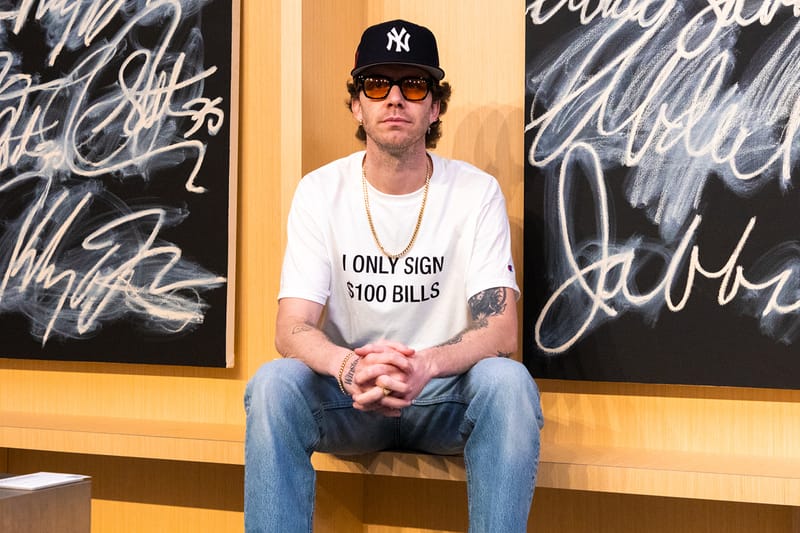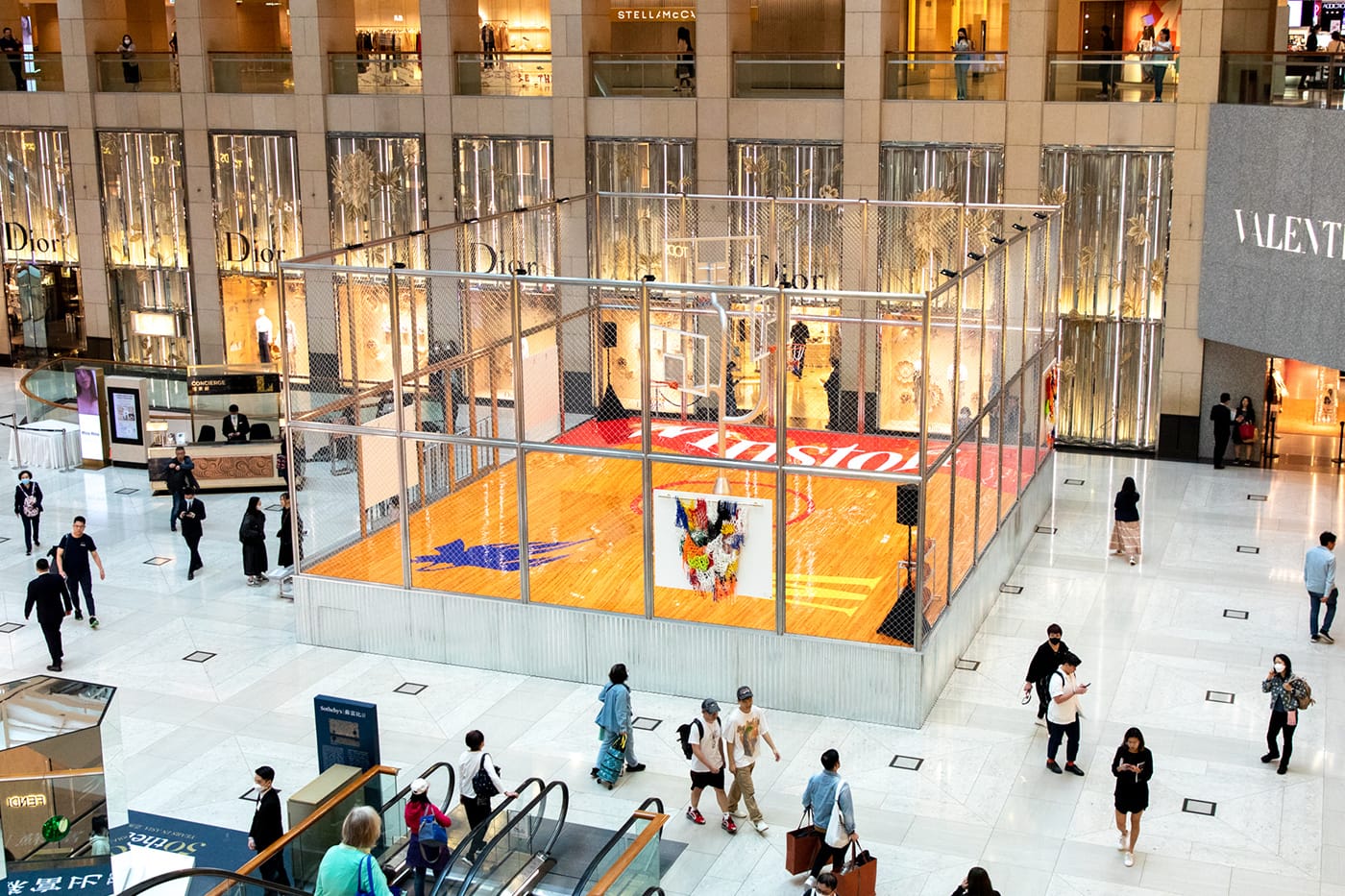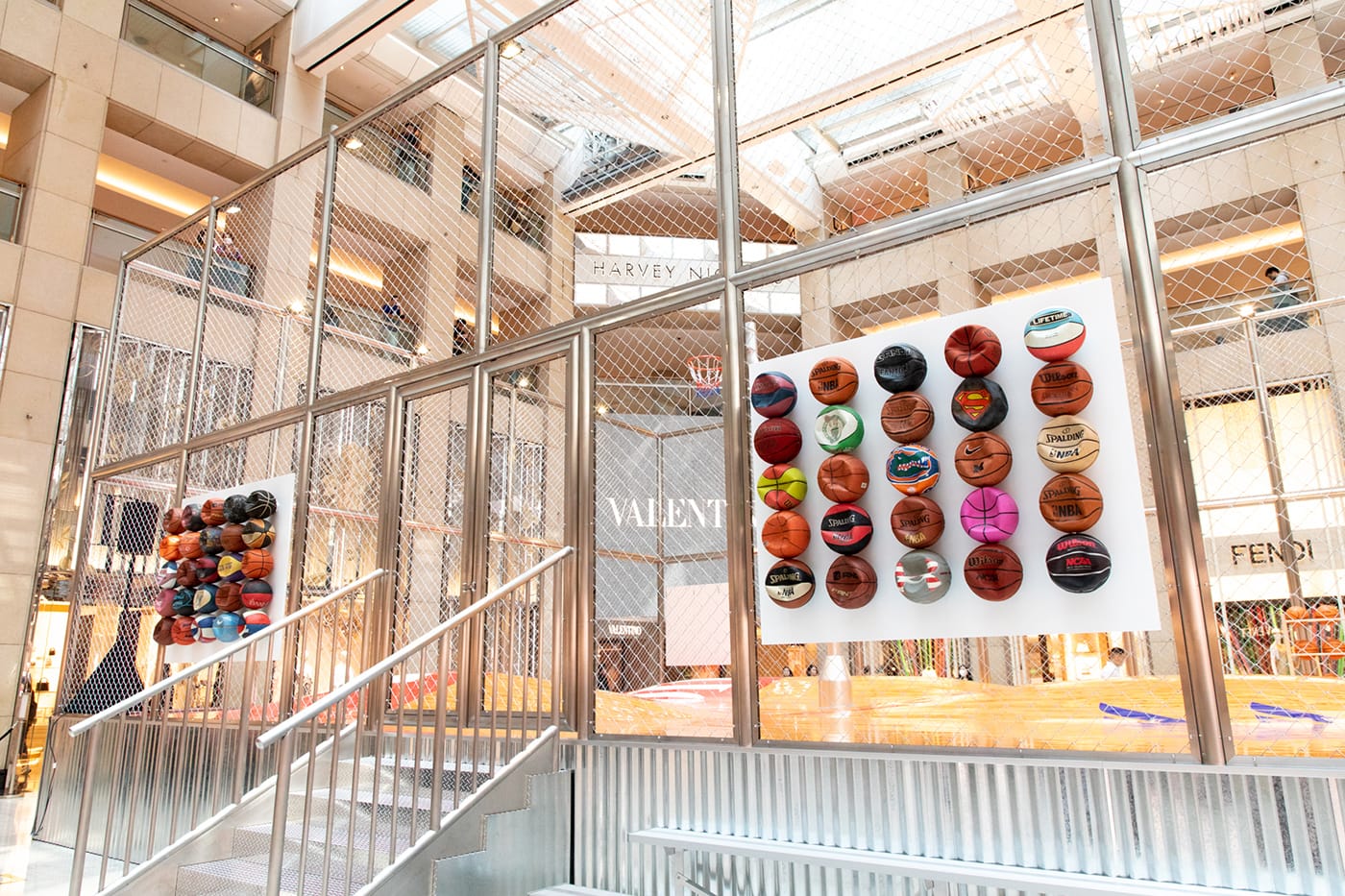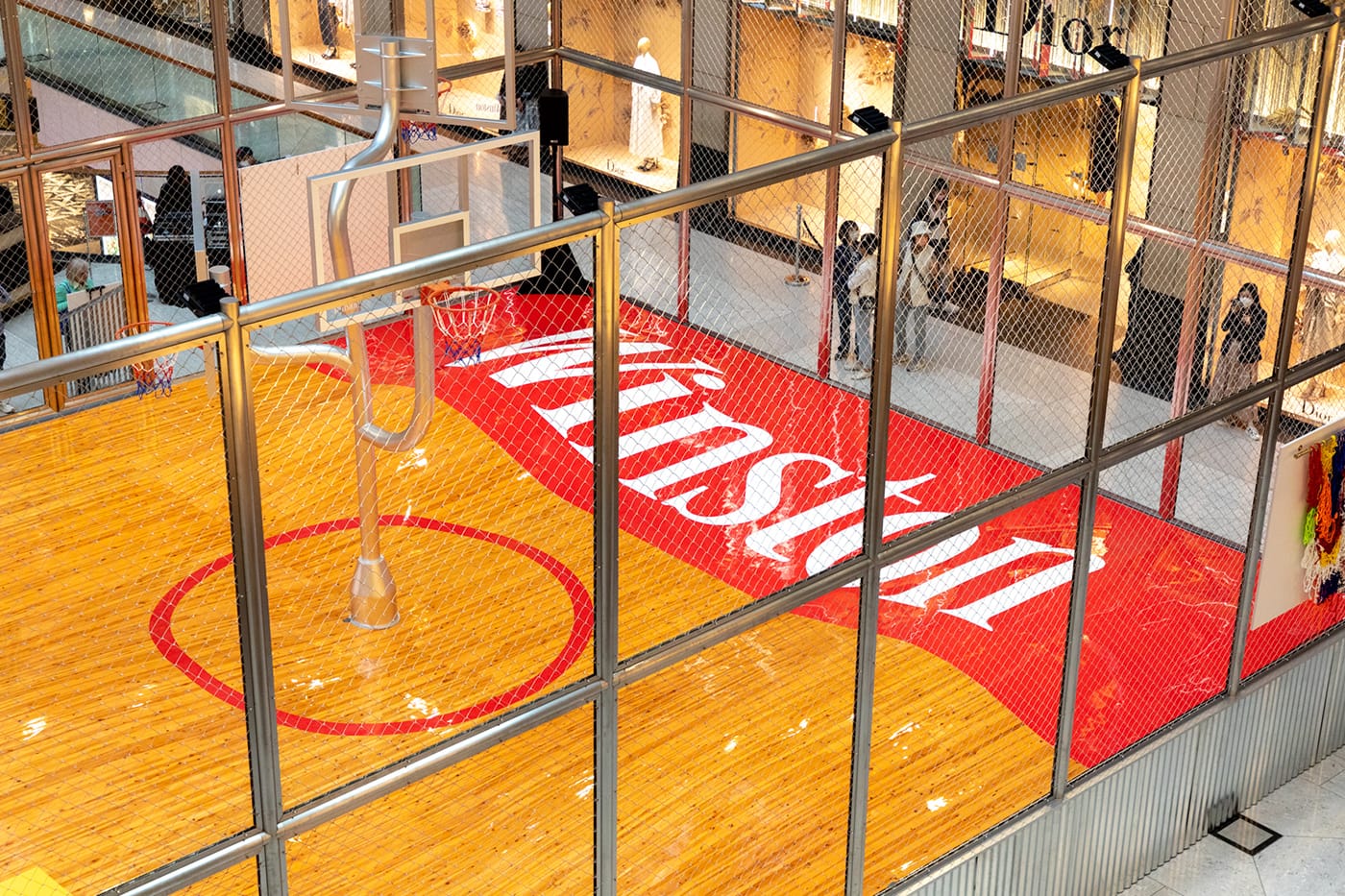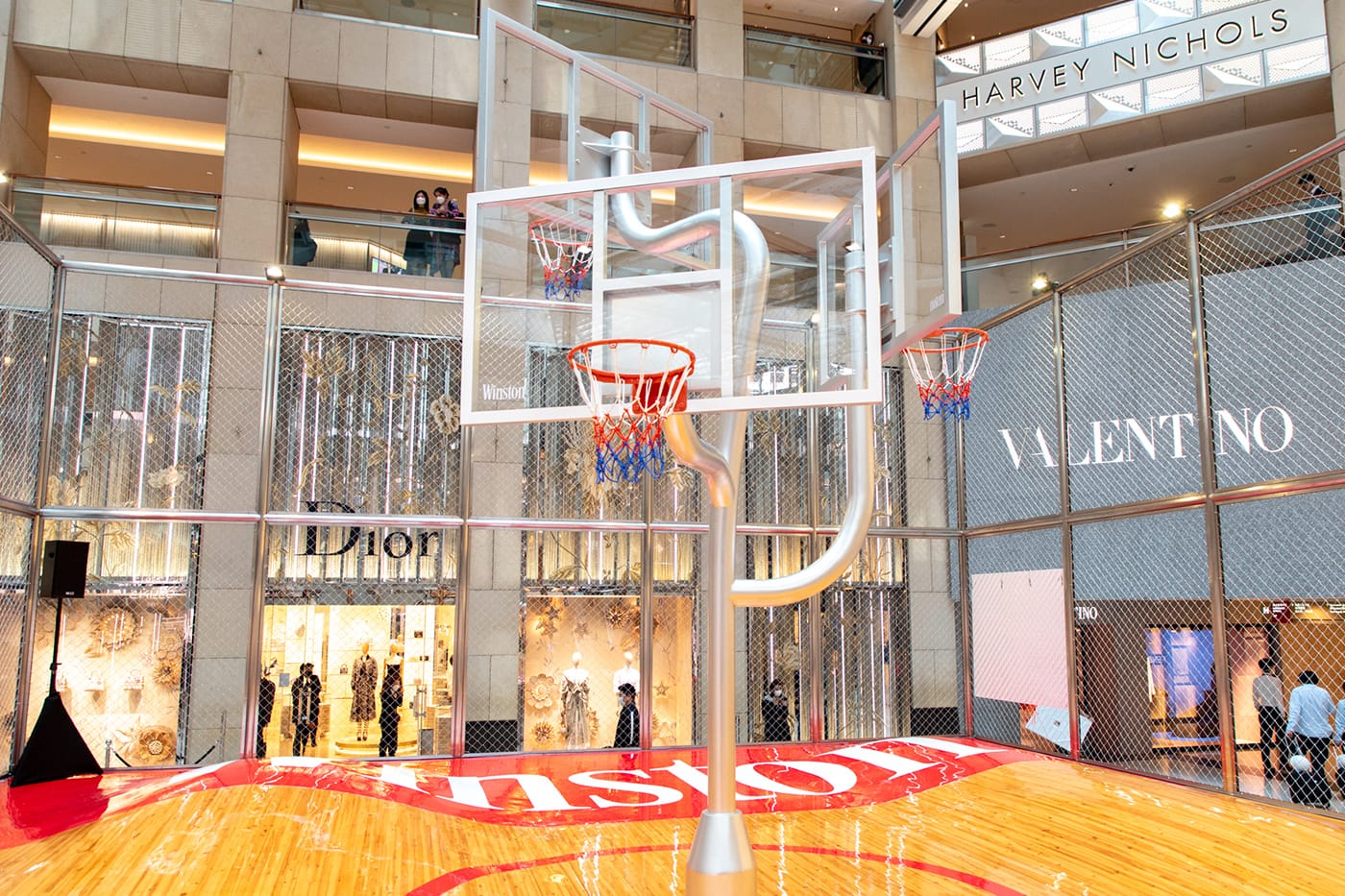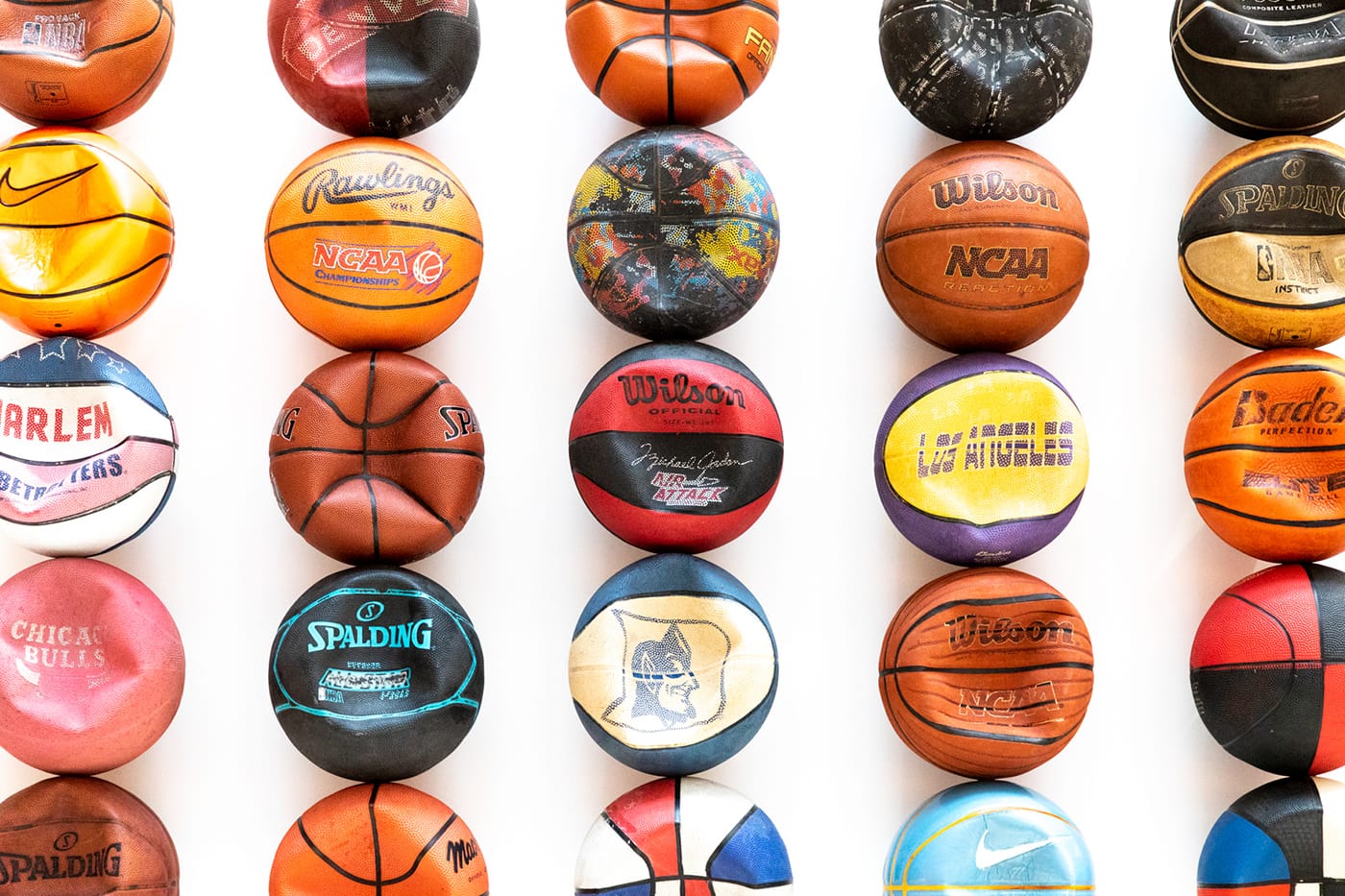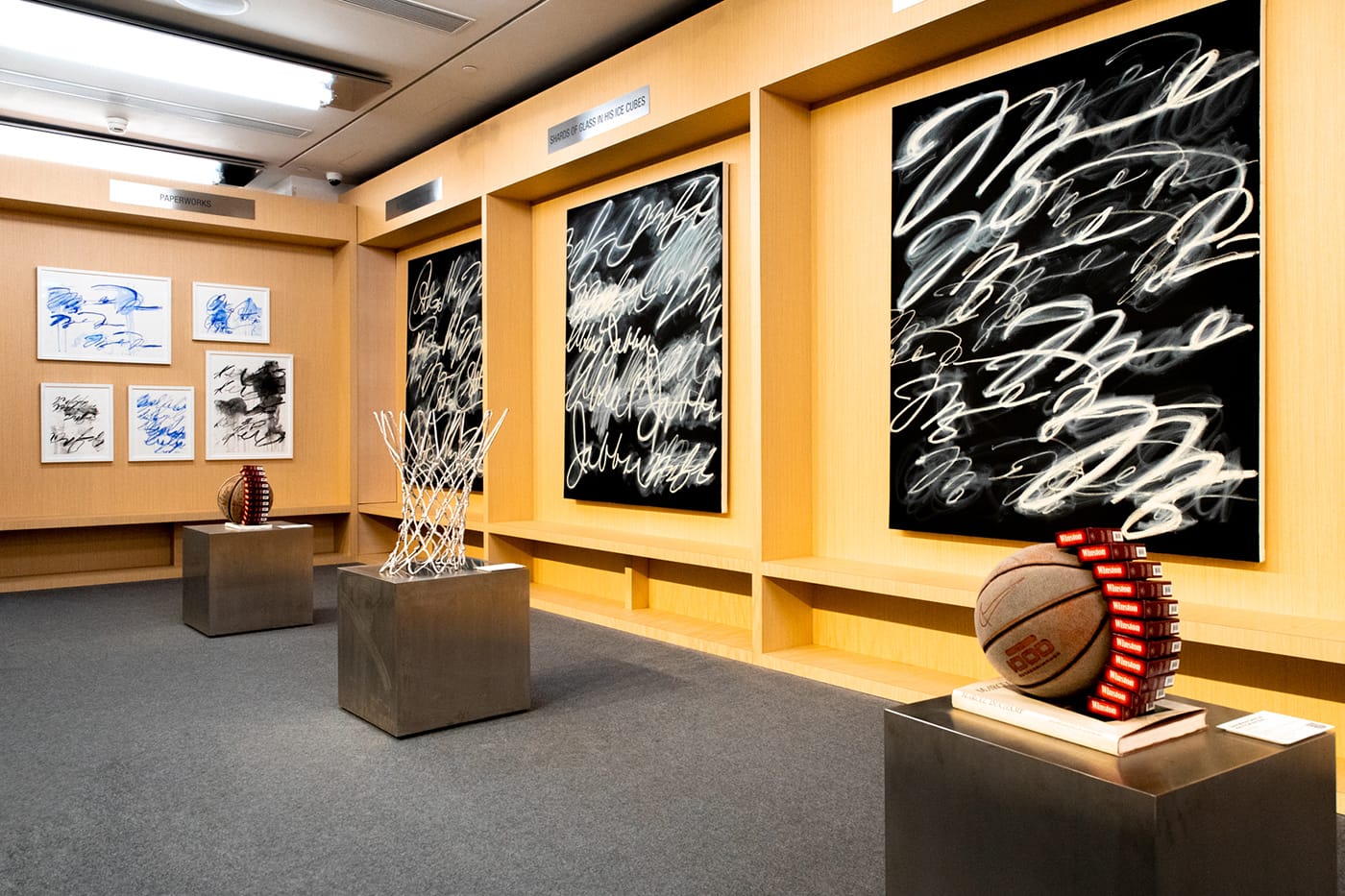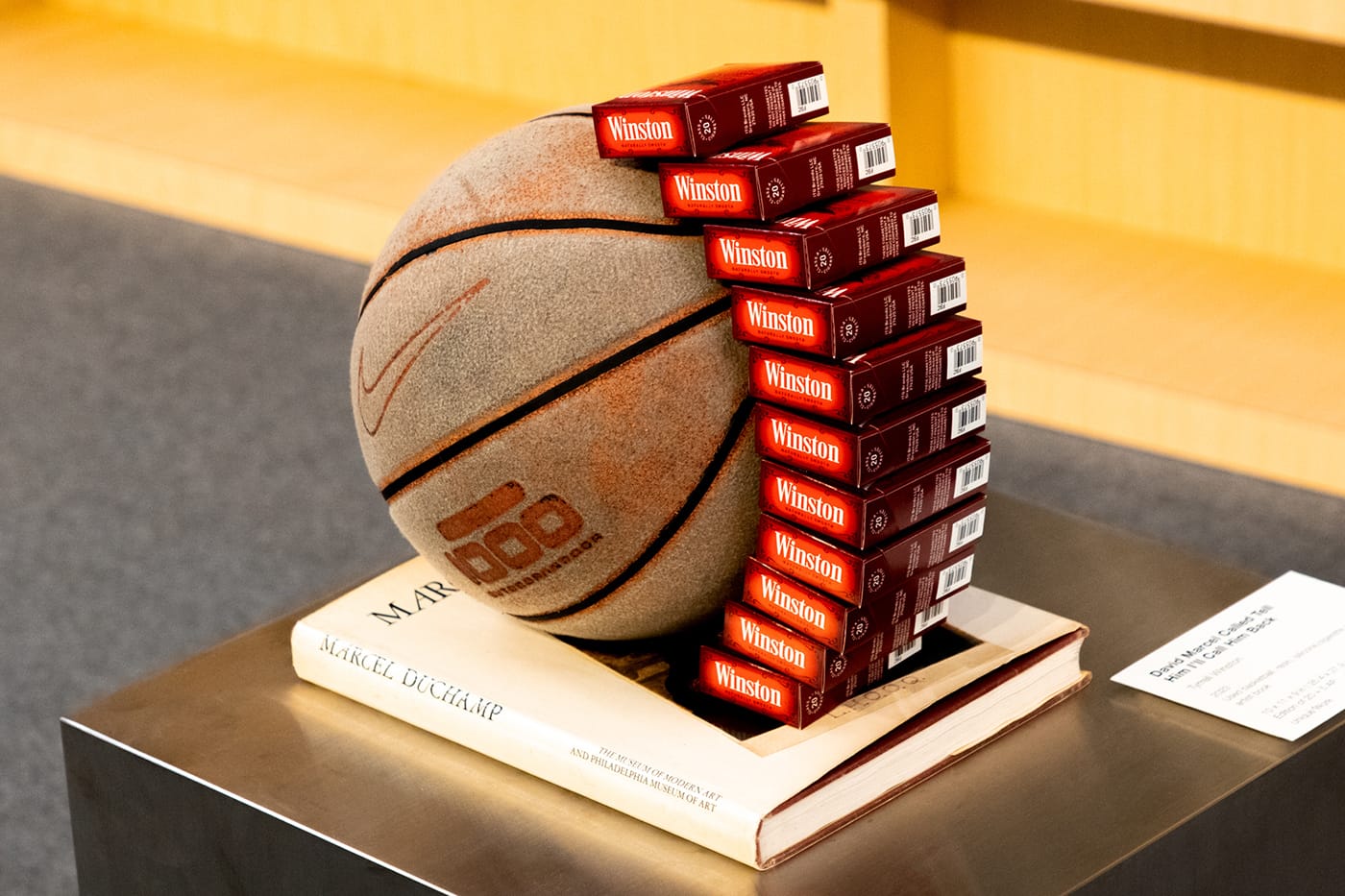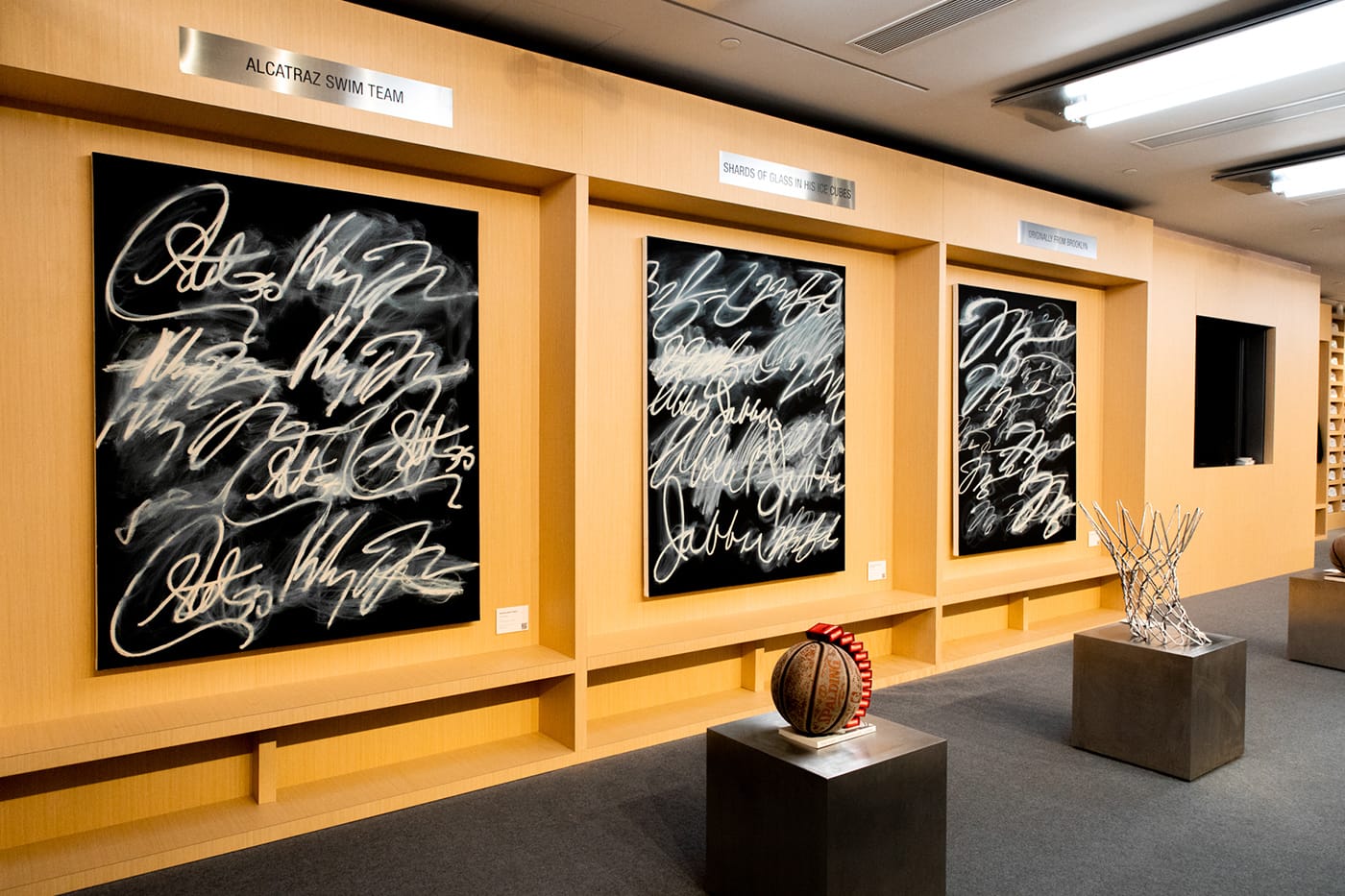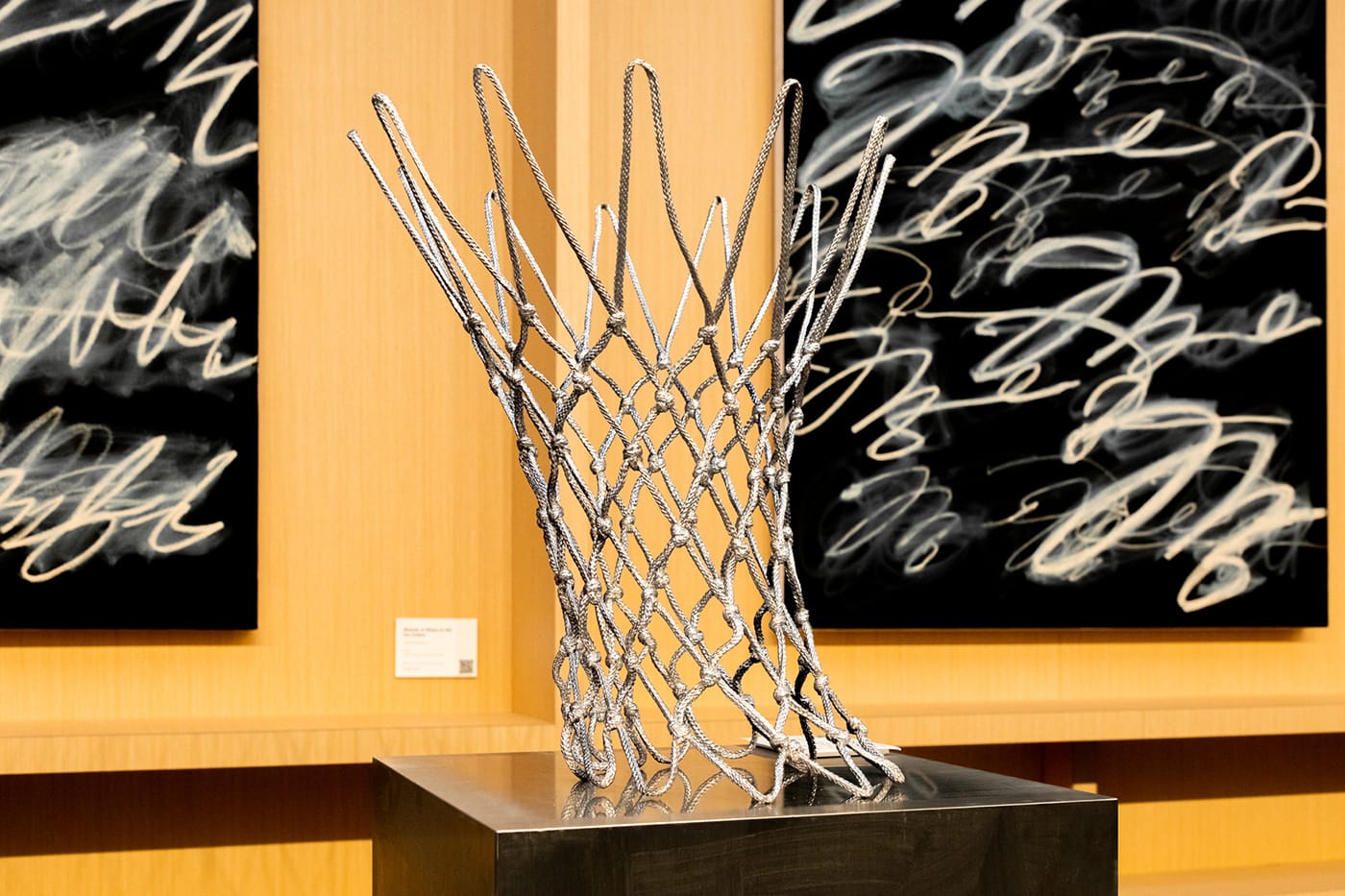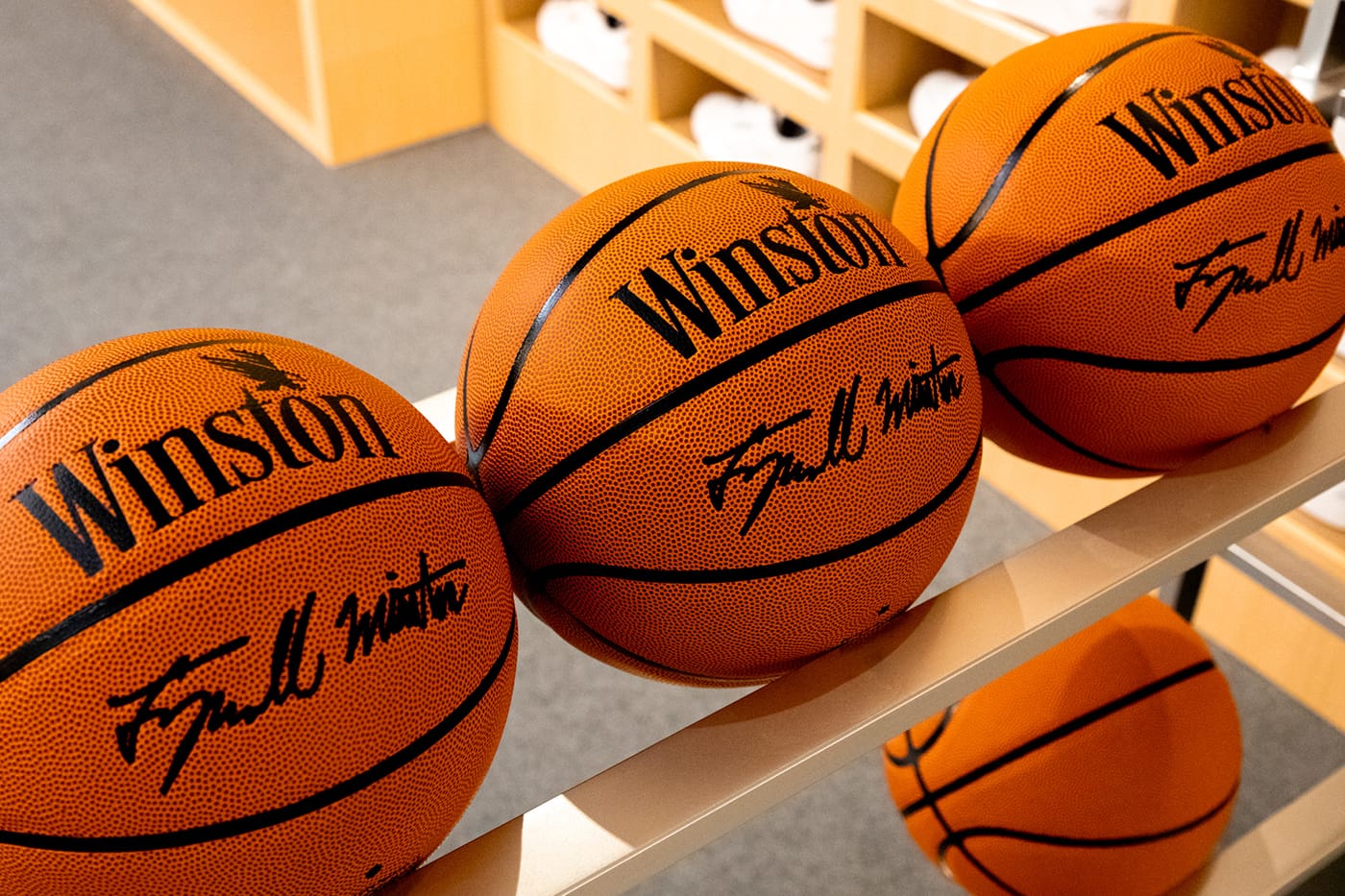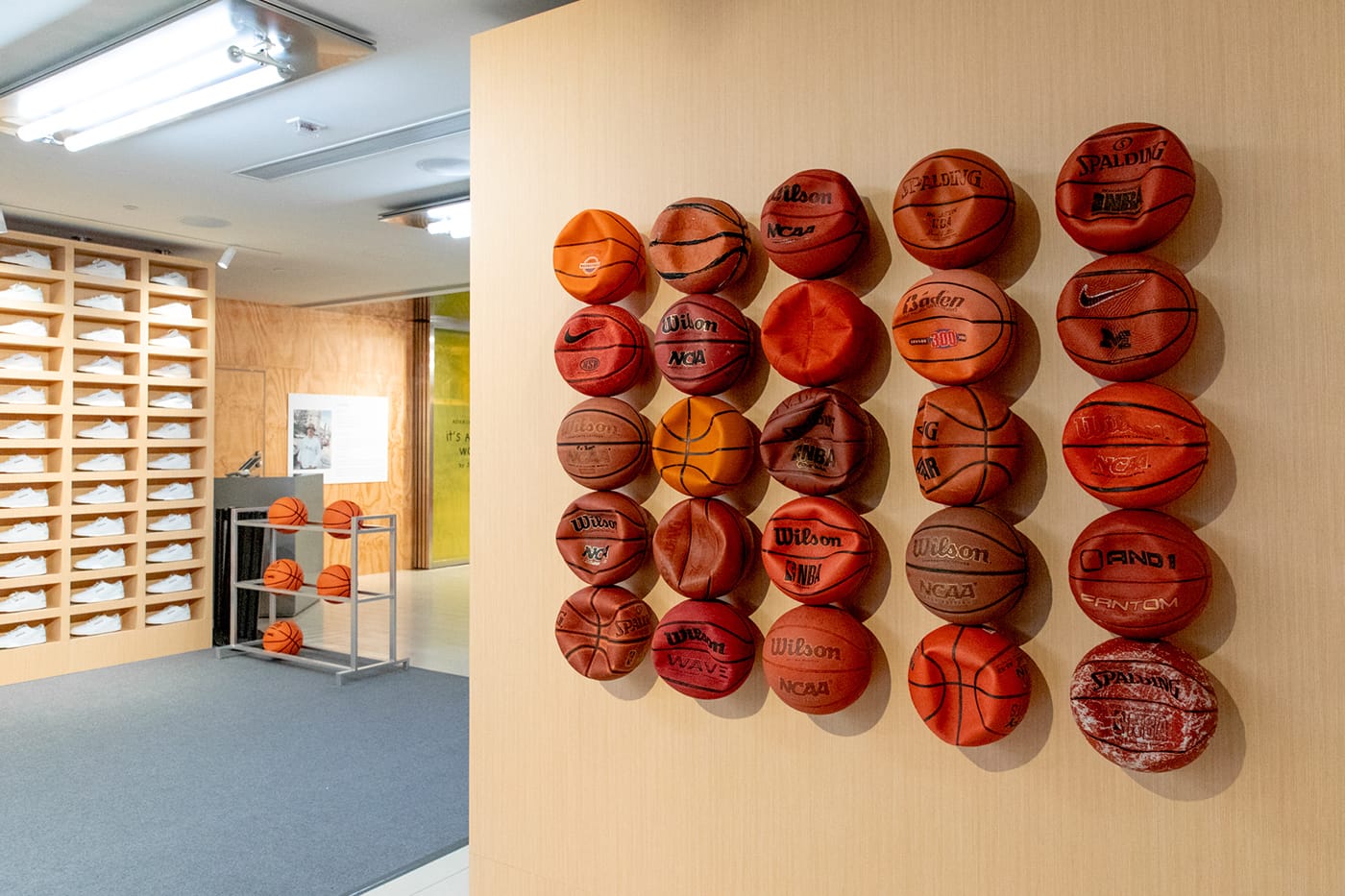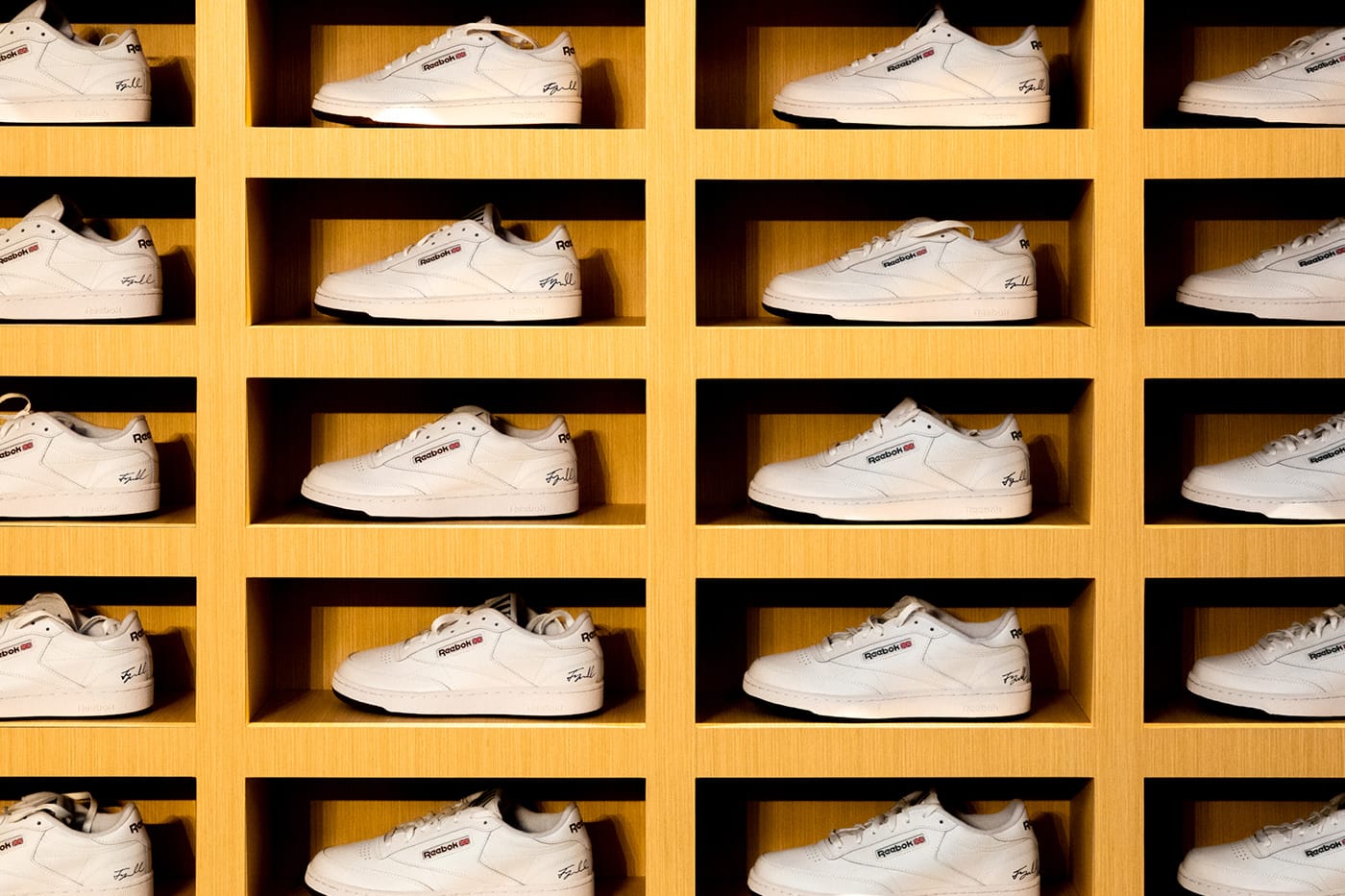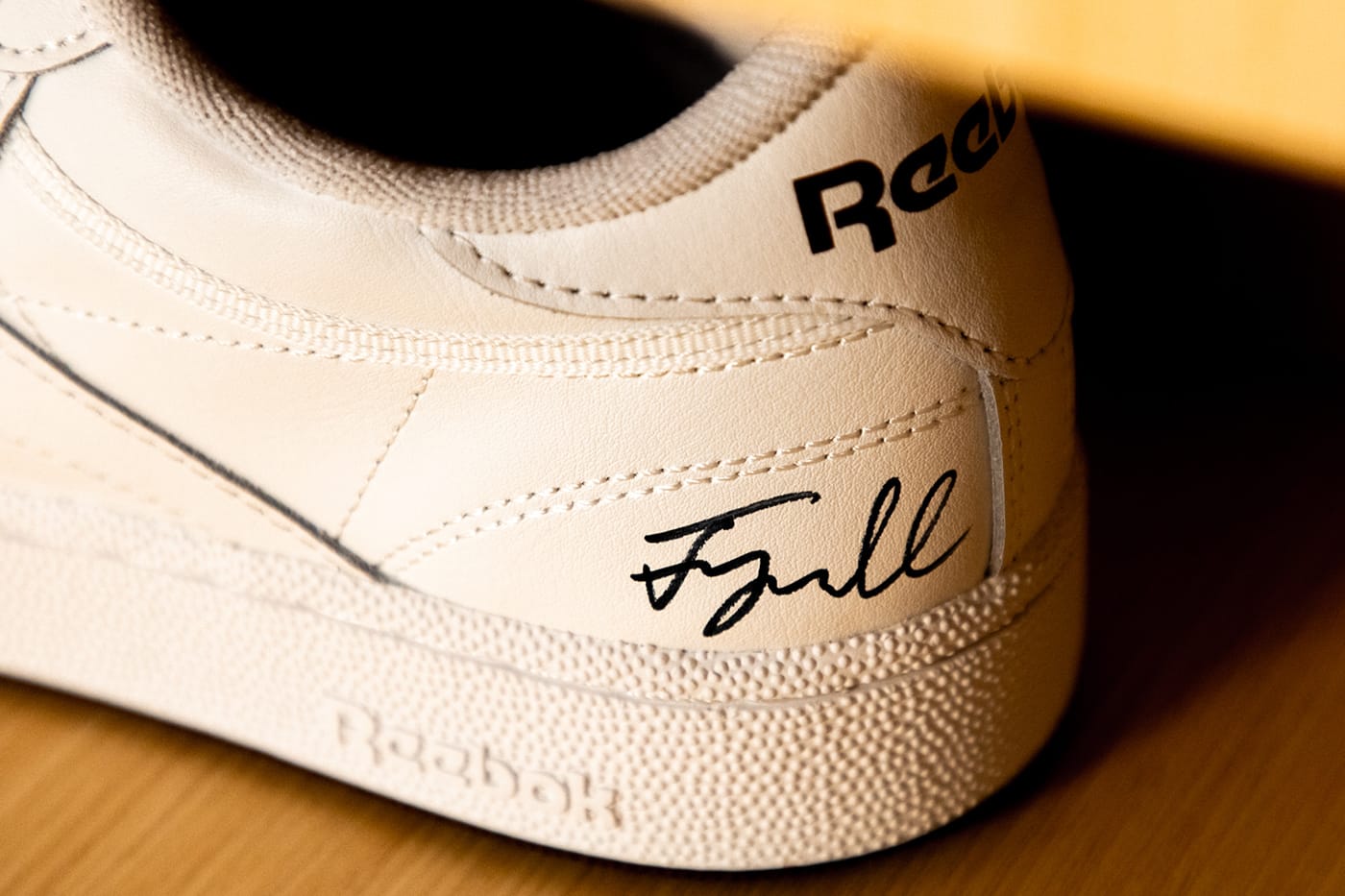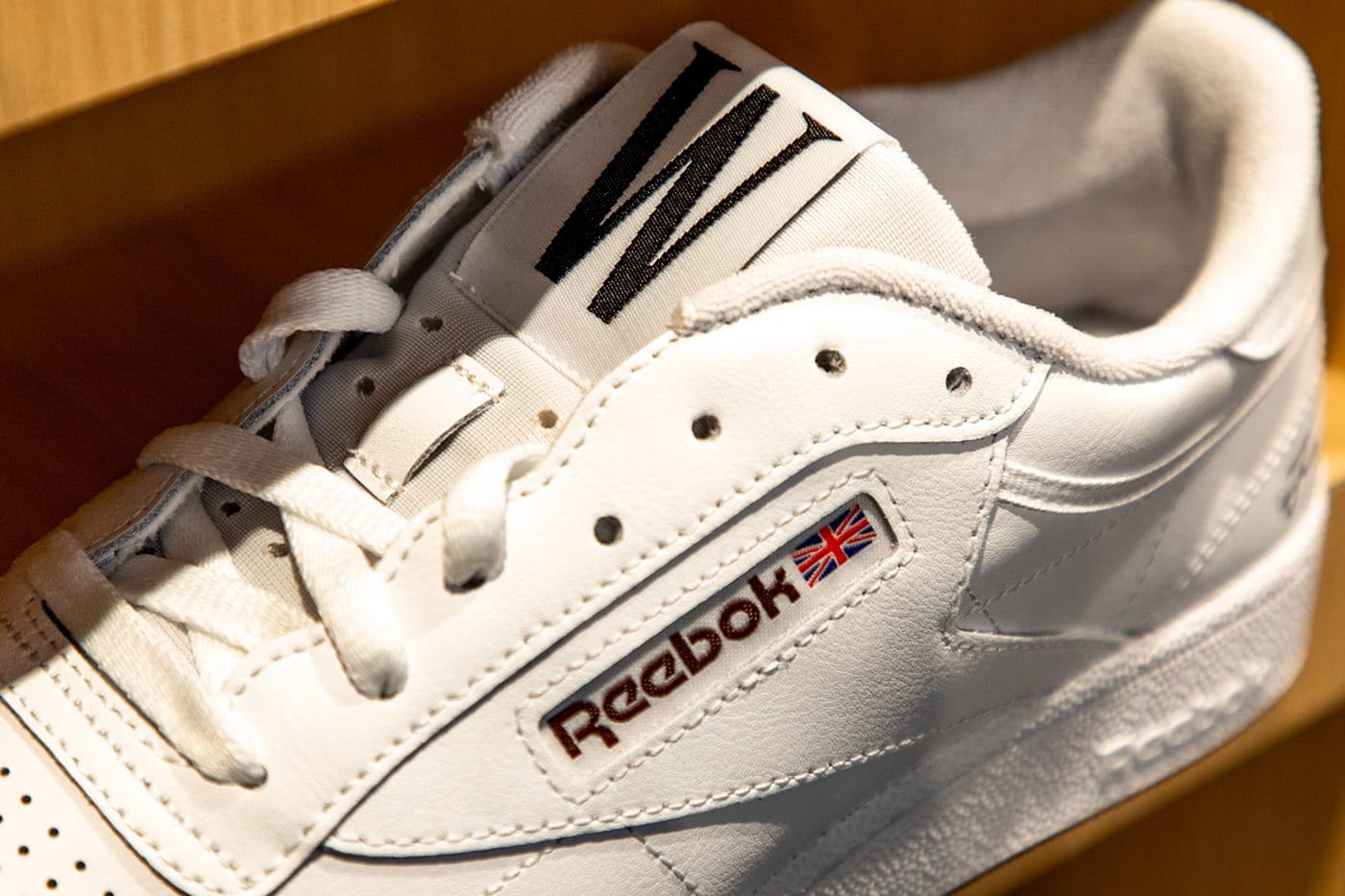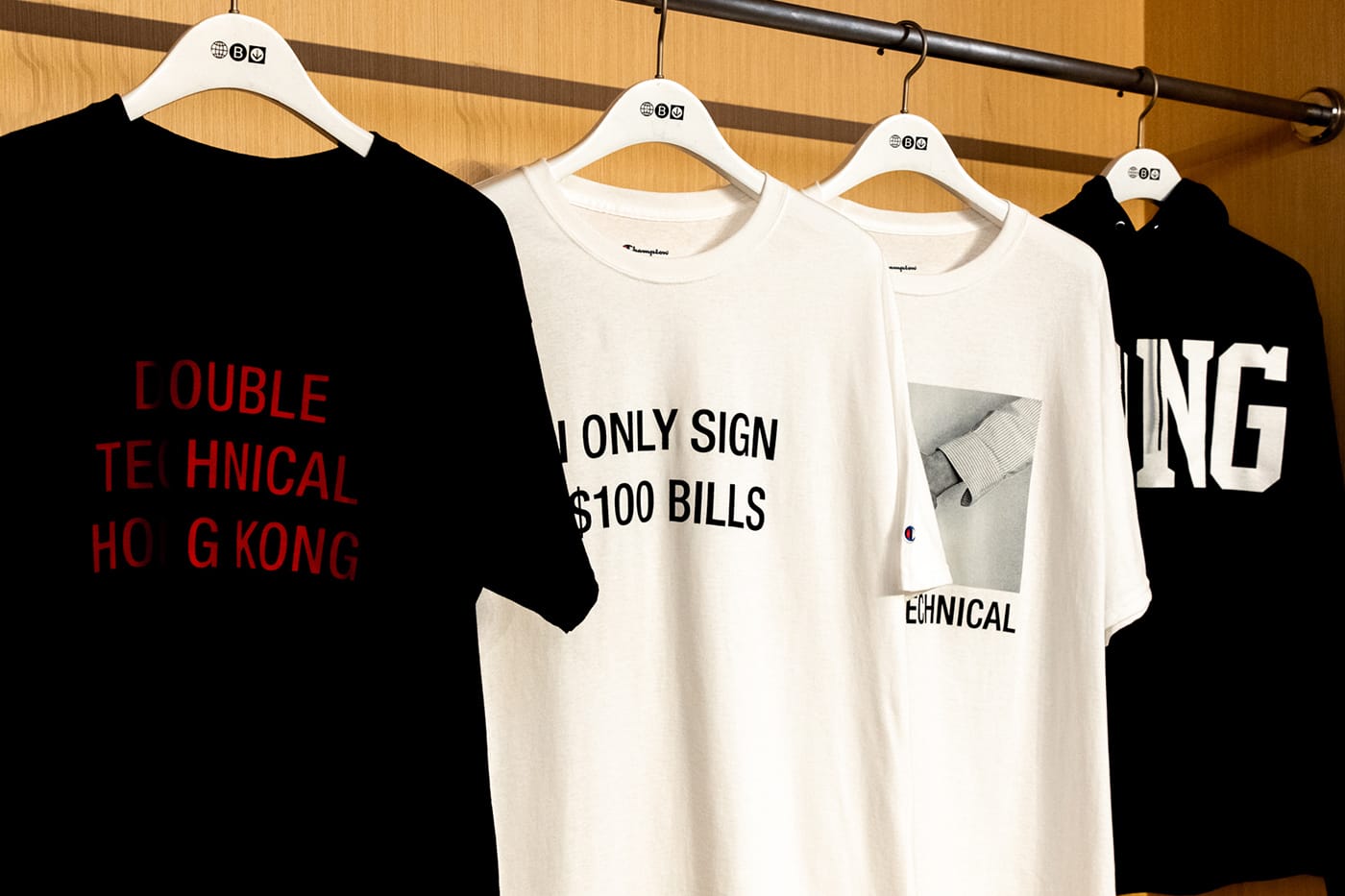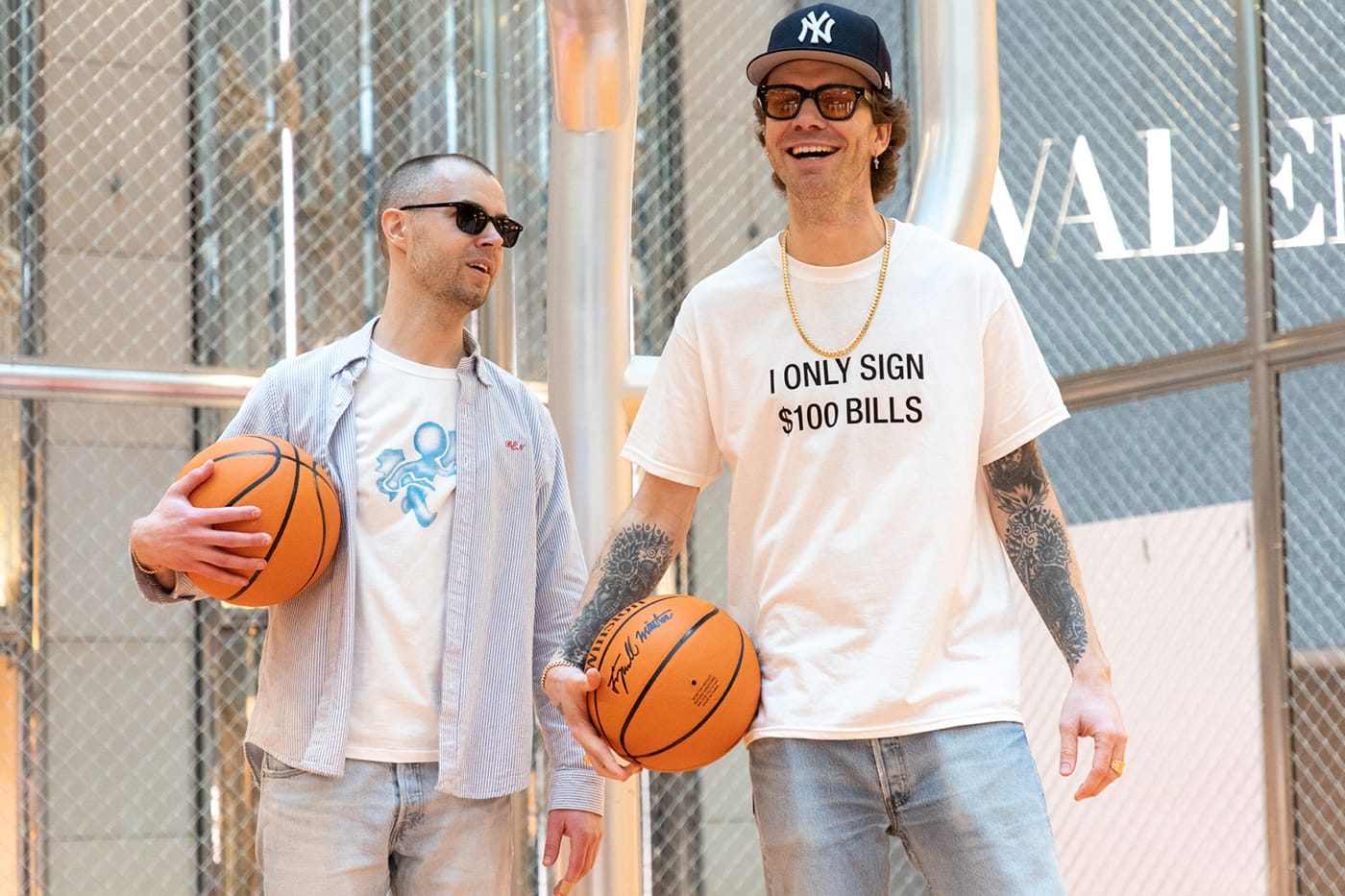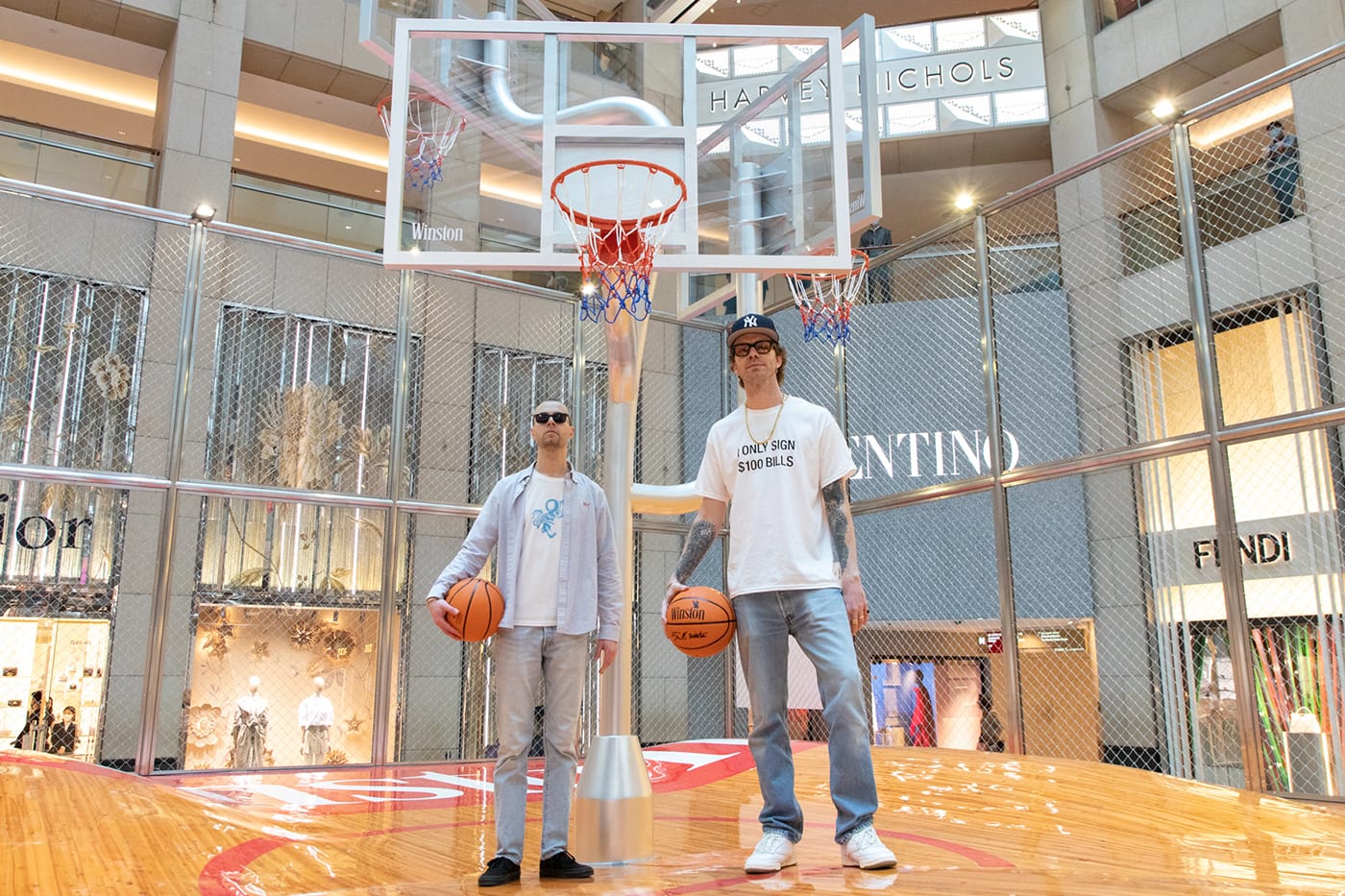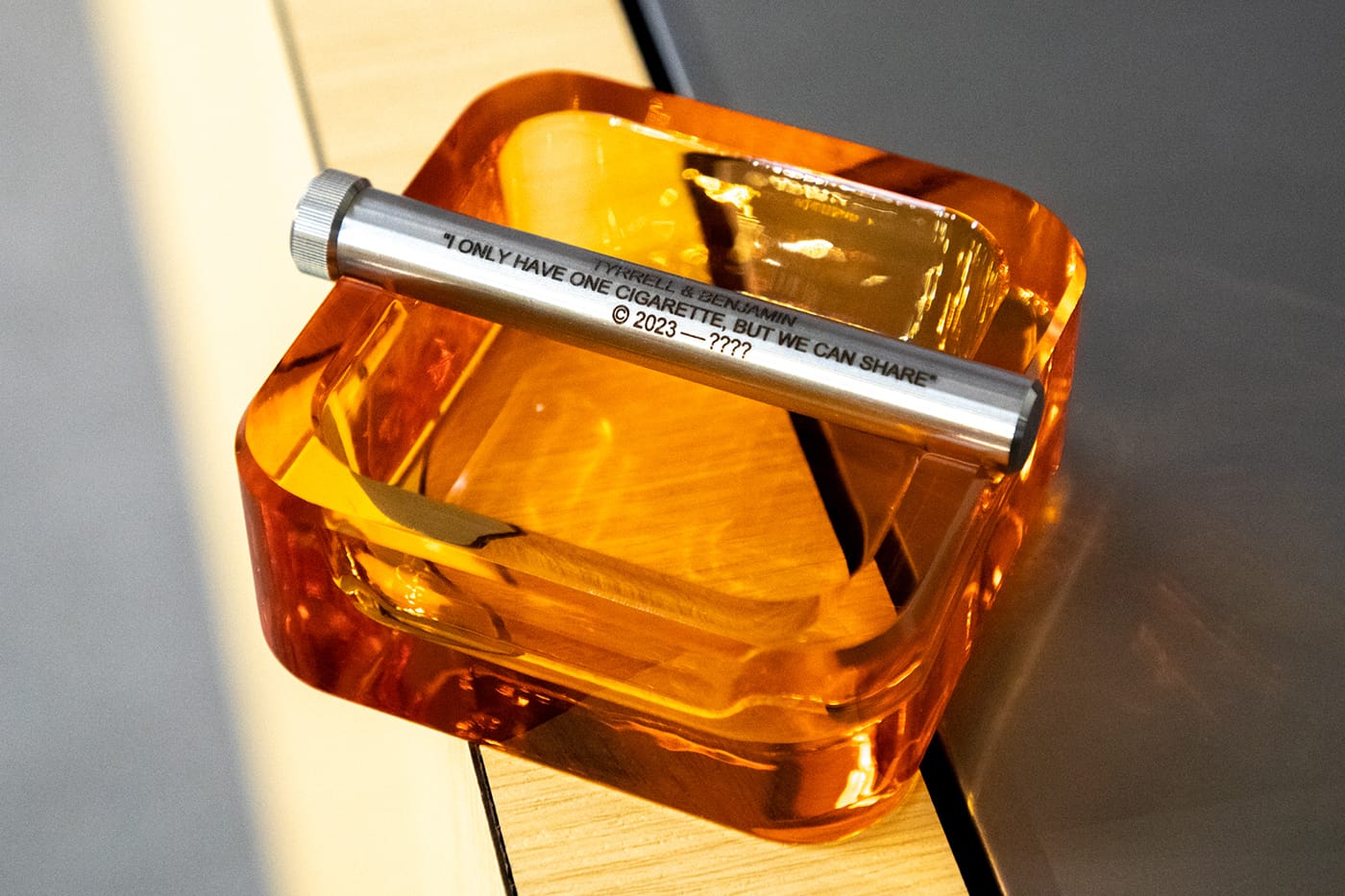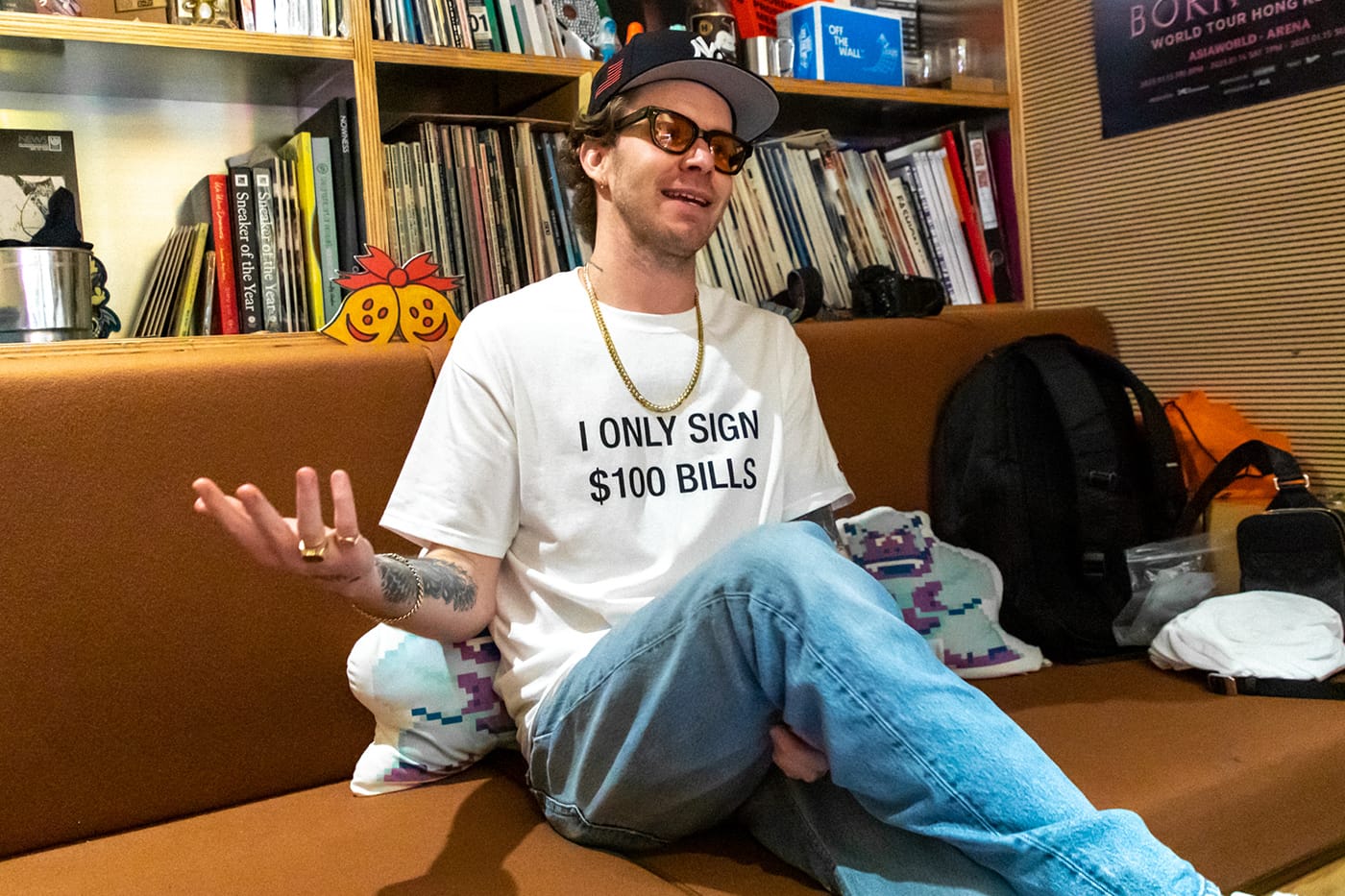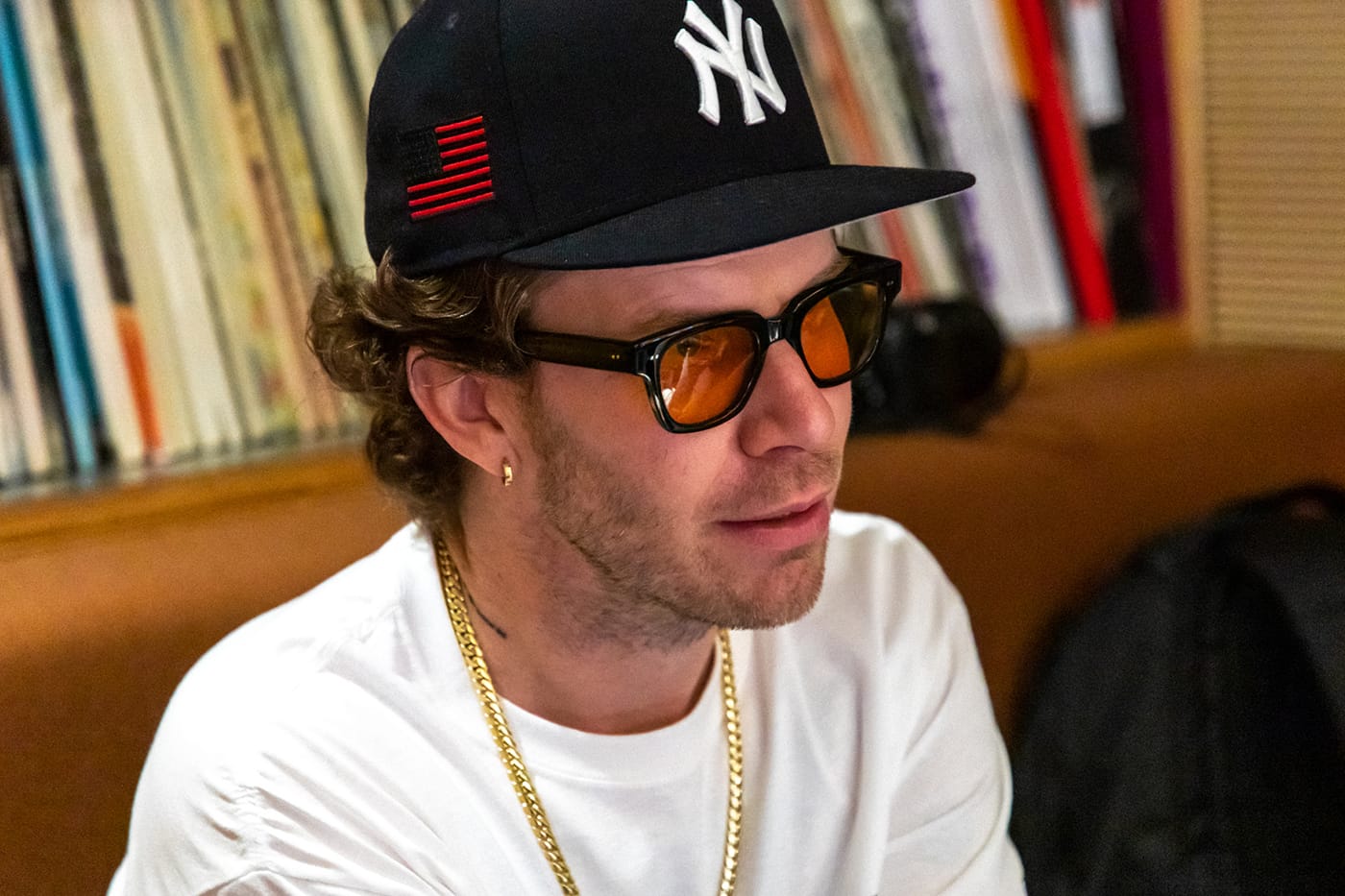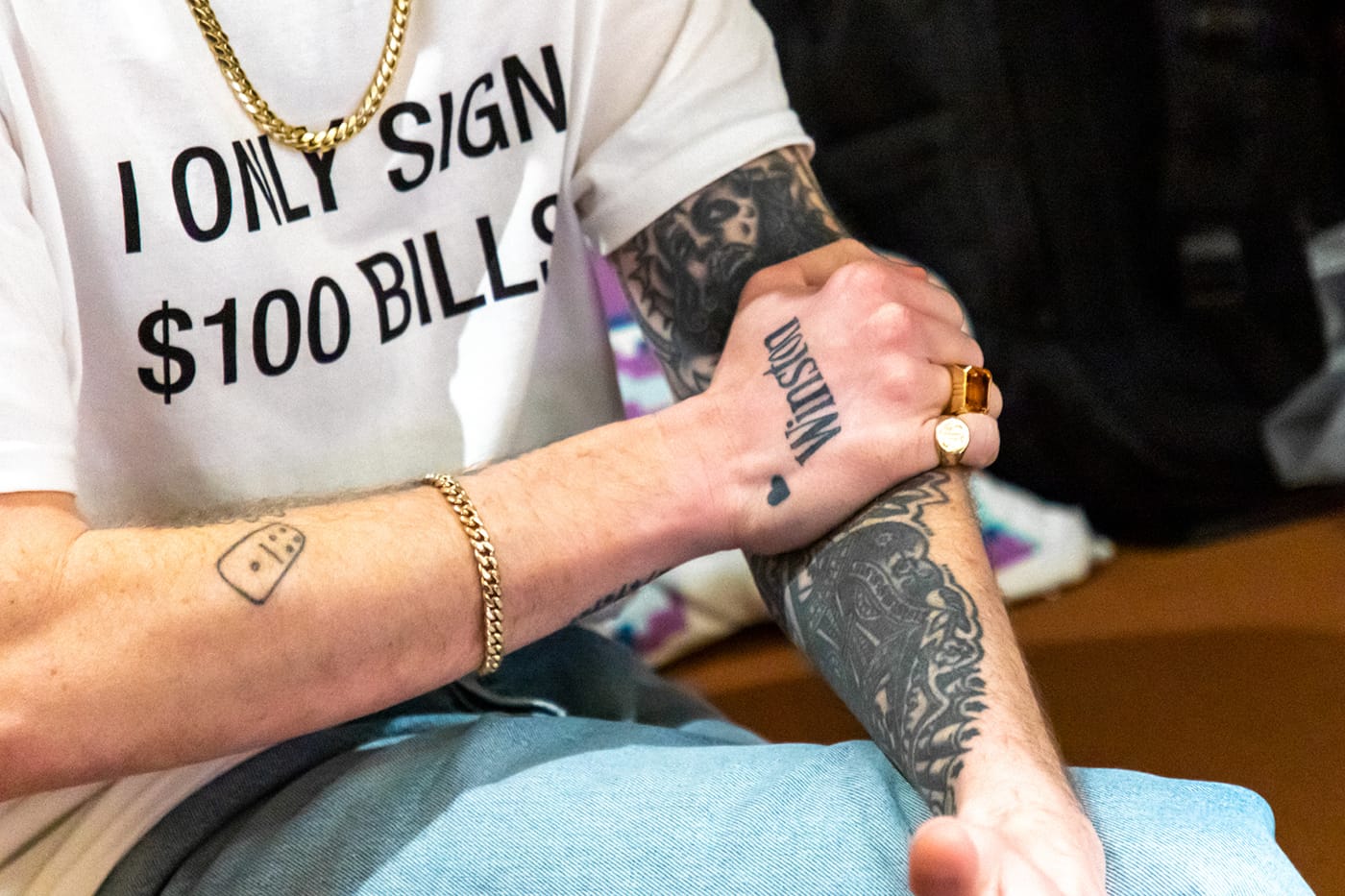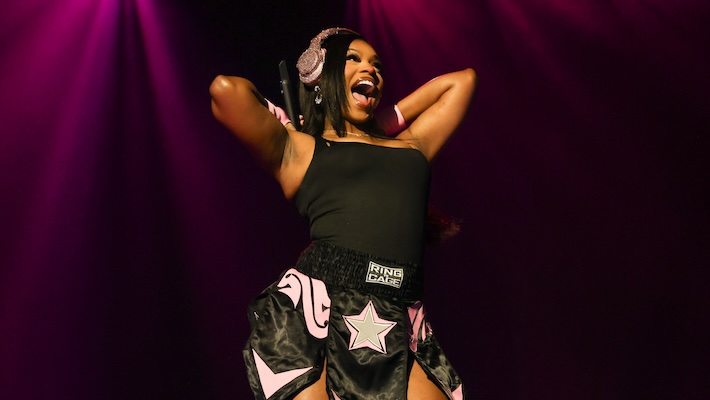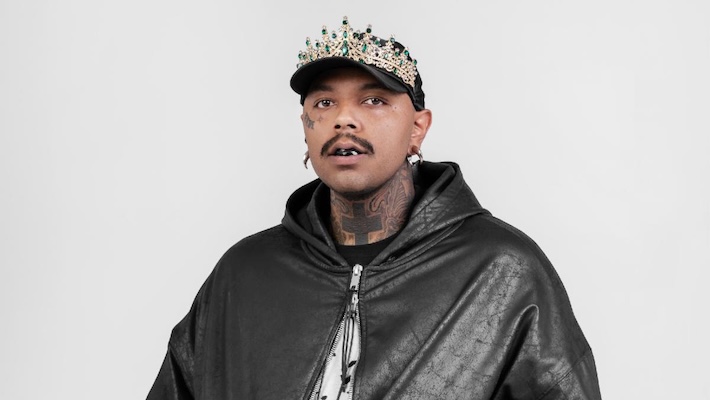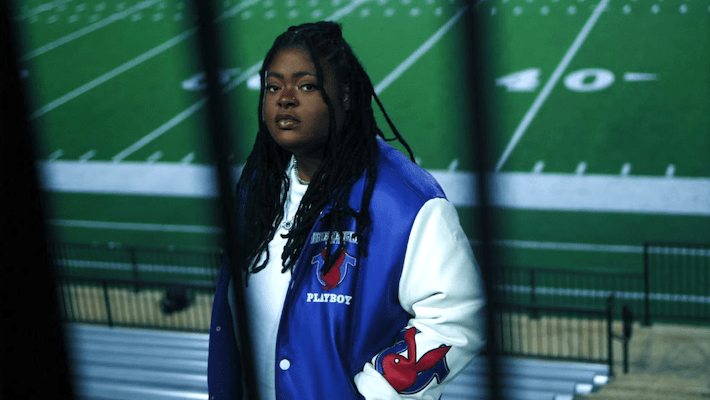In time for Art Basel, Tyrrell Winston has set up Double Technical, his first exhibition in Hong Kong. Located in Landmark Atrium and at the heart of the city’s bustling financial district, Winston’s unique basketball court takes center stage inside the mall. Stretching 12 meters long and 10 meters in width, the installation takes on an almost squarish setting, where it houses three basketball nets of varying heights, atop a surreal and warped ground.
Moving downstairs onto the BELOWGROUND space, the installation continues with a number of new works, where the American artist invites visitors to explore the ideas of “embedded history†through his display of mixed media works, apparel, and a shelf filled with customized Reebok Club C sneakers.
Just before the exhibition was unveiled, Tyrrell Winston sat down with Hypebeast to discuss the messages in Double Technical, his artistic journey, inspirations, as well as his special friendship with Benjamin Edgar Gott.
This is your first time showing in Hong Kong, how was the flight here?
The flight was pretty okay. I slept a lot and I feel rejuvenated, which is surprising because I think a lot of times when I do international travel, it takes me a day or two to adjust. I mean, there’s also the adrenaline – I’ve never had the chance to install something like this anywhere before. I’ve wanted to make a warped basketball court for a really long time, so I want to spend as much time with it as I can while I’m here.
Why Hong Kong specifically?
I think Hong Kong is at the forefront of the art world right now. It’s really exciting. I’d say Hong Kong collectors, and Asian collectors at large are really interested in contemporary American work. I feel very welcomed here as people are genuinely curious about what I’m doing. It just made sense to do this installation here.
You mentioned that you wanted to build a warped court like this for a long time. What was that creative process like?
So a lot of my work stems from things that I see on the streets of New York, Detroit, and California, as that’s where I’m from originally. I mean, it’s wherever I’m taking in my environment. There are a lot of dilapidated courts in different metropolitan areas, in abandoned high school gyms, or just elementary school gyms. Sometimes the floors warp, and I’ve always found that interesting because the floor is supposed to be flat.
It’s this idea of uneven grounds which I find an interesting analogy for the art world, like how it’s a game and a carnival of sorts. So I thought, why not make one? Make it my own thing. I guess the idea of participation and accessibility is really important to me, especially in my work.
So much of the art world can be exclusionary and it’s all “don’t touch†and “this will break.†Now, I’m inviting people to engage with and participate in the artwork. While the work is rooted in art history, it’s also super playful. I want children to be able to engage with this and not be intimidated by it.
Is that the reason why the three basketball hoops were in varying heights?
Yeah, I didn’t want just the traditional two hoops on either end and kind of like a warped tree as well. I was trying to shoot on the tallest one earlier which was like 13 ft tall and it was really hard. If you’re used to shooting on 10 ft basketball hoops, this just feels different. And then it’s also very discombobulating to shoot on an uneven floor, but I think that’s fun.
“I’m inviting people to engage with and participate in the artwork.â€
Looking at your other pieces here, there’s obviously a lot of sneakers, especially Reebok ones. You’ve also done a lot of sneaker collaborations in the past. How did this love for sneakers come about?
I grew up playing basketball and skateboarding a lot, so shoes have always been a pretty important part of my life. I’m not a sneakerhead – I have a lot of shoes, but I’m not precious about any of them. I beat them all to sh*t. And the Club Cs have always been a go-to shoe of mine. It’s also the only shoes I wear in the studio.
When I was approached by Reebok some years ago, they’d originally just asked me to do a basketball shoe and I said, hey, I’m not going to do basketball shoes, I want to do a Club C. In the end, we decided to do a basketball shoe and a Club C, so everyone was happy. It was also really cool because Allen Iverson was and still is one of my heroes. So, I was able to have my own Iverson shoe and a Club C in 2022.
Now, the ones here are of a limited run of 100 and are exclusively available for this event. In Fall, I’m doing another iteration of my Club C and the Reebok Classic for the Classic 40th anniversary, which I’m super excited about.
When you’re working on these collaborative projects, is the creative process quite similar to when you’re creating your art?
It’s funny. I look at these shoes, and I don’t see them as art. The shoes are an extension of my work. A lot of the stuff that I think about when working has to do with style or uniform, and comfortability on a certain level. Many of my friends work in fashion and design as well, so when I’m creating and choosing the materials for the shoes or a T-shirt, I think about if this is something I’d wear, and whether they’re something I want my friends to wear. It’s quite selfish actually, and most of it is kind of either tongue-in-cheek or really simple. Just like how I love a simple white shoe, I don’t like stuff that’s not too in your face,
The original Club C design was already really well-thought-out. So, I thought about what I could add to it. I took away the Reebok branding and then added one of my f*cked-up Yankee logos. I don’t know if I can say that, but again, it’s not really art but it influences the art.
How do you think your art has evolved since your first piece of work?
When I started making work, it was very anti-US-government and very anti-police. I was trying to say something provocative, as a lot of the artists who I still really admire and look up to like Dash Snow, Dan Colen, and Nate Lowman – these guys were part of the post-911 New York art scene. And I wanted to be like that back then.
I was trying too hard on a certain level to say something that was already being said. When these artists started working with sports ephemera and found materials, instead of making collages that literally said something, my work kind of found me. And now it speaks for itself.
Are there any specific artists that you look up to?
So much of my work is about art history. I’m trying to treat art history as it’s already made, and I lean into references. Like these autograph paintings, they’re a conversation with Cy Twombly. He was obsessed with Greek mythology, Roman mythology, and ancient history. I’m obsessed with contemporary mythology, American mythology, the athletes and celebrities that we revere, as well as ideas of mortality.
As for artists that I look up to, there’s Cy Twombly, David Hammons, Jeff Koons, Richard Prince, Sherrie Levine, Cady Nolan… the list goes on and on and on. Whenever I’m making work, I’m constantly thinking about whether I can inject myself into art history and have conversations with these artists.
You collaborated with Benjamin Edgar for some of the pieces in this project. What was it like to work so closely with a friend?
Ben and I are very, very close friends. We talk about art and design pretty much every day. He’s one of the first people I run new paintings by. We have this really beautiful, very honest friendship. I’ve been asked to do a line of clothing and Ben just seemed like the perfect choice.
We have this kind of humor about the way we do things. I mean, the shirt that I’m wearing right now says “I only sign $100 bills†– I think that might get a little lost in translation here because it’s $100 bills in USD. All these things are kind of like tourist merch, we even have a hoodie that just says Hong Kong. Whenever I’m in New York, I’ll buy a bunch of tourist sh*t from Canal Street and I’ll wear it. My love for these places is kind of ironic but also very serious. Again, I just want to make things that my friends would wear. That’s one of the things I care the most about.
“I’m constantly thinking about whether I can inject myself into art history and have conversations with these artists.â€
Sports definitely seem to have an impact on your life. Looking at your recent autograph series with MJ and LeBron, is there a reason why specific athletes were highlighted? And what inspired you to start those series?
I never intended to paint at first – I have such reverence for painting. I’m self-trained and didn’t go to art school, so I’ve been very intimidated by the medium of painting. I began this series at the start of COVID. I was just autographing a pair of Muhammad Ali gloves and a Michael Jordan basketball that was signed by the athletes themselves. I was adding my name and placing myself with the greats, which is a kind of resurrection through desecration.
If you look at Ai Weiwei, he has this very famous photo series where he drops a Han Dynasty urn, I believe. This is a cultural relic and he’s literally adding value to it by breaking it – that was kind of my mindset. Or like Robert Rauschenberg’s Erased de Kooning Drawing – Willem de Kooning was very famous then, while no one knew who Robert Rauschenberg was. These paintings started as performances.
So much of my work, my best works in fact, are all very simple. It’s mostly just one object that already exists, like a basketball or a cigarette. Why not make a mark on something that already exists? Like taking someone’s autograph and painting over them.
There is this “single cigarette case†that you guys made together. Can you tell us a little bit more about it?
So, Ben has this single-cigarette-after-dinner case. You know, smoking isn’t cool. We know it’s bad for you. But like, smoking is also f*cking rad. So at the same time, those things are kind of like a celebratory moment of our friendship. We’ve spent a lot of time at bars, out and about late at night. The case says “I only have one but we can share †which works as a commemoration and a souvenir of our friendship. Not to be all sentimental, but that’s what it is, and it’s really cool. It’s funny when Ben started making those, he had a number of people tell him they really want it, even though they don’t smoke. I mean it’s just one cigarette, and then it’s about moderation.
How did you guys become friends?
I was literally his fanboy. Ben was brilliant with the things he did, like his An Object Company with The Brilliance, which he did with Chuck Anderson and Virgil Abloh. I was following all that when I was in college/ right out of college thinking how cool it was. I was getting these long-form interviews of these cultural figures at the time, like Aaron Bondaroff, Tom Sachs, and all those people that were shaking things up, but not a lot of publications were covering them at the time.
So I’ve been familiar with Ben forever, and through mutual friends, he contacted me. He was helping with the store Notre at the time. I had developed an art program back then when they acquired a piece, and Ben just happened to be the point of contact. He visited the studio and we just hit it off.
He’s one of my best friends. He even traveled here with me, and sometimes he’d stay with me in Detroit, we’d go out in New York, and I’d visit him in Chicago. It’s a very beautiful friendship, and I’m very lucky to have a friend like him.
“Why not make a mark on something that already exists? Like taking someone’s autograph and painting over them.â€
Will you be going to Art Basel?
I’m just gonna go to the fair. You know, fairs are so funny because it’s such a sh *t show. It’s like the worst place to see art, but it’s also super exciting in a way like cattle seeing art. I want to go before most of the other people get there, because I want to be able to actually experience the art and not see the top of people’s heads or their iPhones. I’m super stoked as this is my first time in Hong Kong. So it’ll be cool to attend the biggest art fair here.
Are there any artists you’re looking forward to seeing at Art Basel?
Honestly, I don’t even know who’s showing! I’m sure I’m familiar with a number of the people that are showing. But I think this is the perfect time to do the Double Technical exhibition while people are here to see Art Basel. Hopefully, it’ll be refreshing for them. If the fair gets a little stuffy, they can come here, look around, and find out. I can think of some friends who will be happy to be left in the warped court for hours. I feel kind of bad for the stores around it because those balls are really loud. But whatever, that’s part of the experience.
Any hints on upcoming projects that are in the works?
Yeah, this is a busy year for me. I have two new Reeboks coming out this Fall, a solo show opening in Athens which will feature a very special collaboration, but that’s on the DL. And then I’m doing a solo booth at MIA Art Fair in Milan next month, where I’ll be showing some new blue autograph paintings. I’m also doing a two-person show in Paris with the artist Richie Culver in September, which will be rad because I love Richie’s work.
Tyrrell Winston’s Double Technical installation will be on view in Landmark Atrium, Hong Kong until March 31.
Landmark Atrium
Landmark Atrium, 15 Queen’s Road Central,
Central, Hong Kong
In other art news, check out the list of must-see booths at Art Basel Hong Kong 2023.
